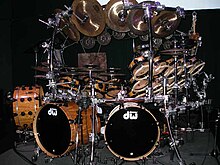A thunder sheet is a thin sheet of metal used to produce sound effects for musical or dramatic events. The device may be shaken, causing it to vibrate, or struck with a mallet. It is also known as a thunder machine, though this can also refer to a large drum used for a similar sound effect.[2]
 A thunder sheet at the Teatro della Pergola | |
| Percussion instrument | |
|---|---|
| Other names | Thunder machine; machine à tonnerre (fr); Donnerblech, Donnermaschine (de)[1] |
| Classification | Percussion |
| Hornbostel–Sachs classification | 111.221+112.1 (Individual percussion plaques, or the player makes a shaking motion) |


Thunder sheets are available from some cymbal makers including Paiste and Sabian, or can easily be made out of any scrap metal sheet. The thinner and larger the sheet, the louder the sound. The thunder sheet needs to be "warmed up" before sounding. The player(s) will need to start slowly shaking the sheet a few seconds before quickly shaking the sheet.
Usage
editDramatist John Dennis devised the thunder sheet as a new method of producing theatrical thunder for his 1709 tragedy Appius and Virginia at the Theatre Royal, Drury Lane, London.[3] His invention was stolen by another theater play, and that gave rise to the phrase: "stole my thunder".[4]
Notable orchestral works in which the instrument has been used include the following:
- Richard Strauss: Eine Alpensinfonie and the opera Die Frau ohne Schatten
- Giuseppe Verdi: Otello
- Richard Wagner: Der Ring des Nibelungen[5] and Parsifal.
- Mozart: The Magic Flute[6][7]
- Ignacy Jan Paderewski: Symphony in B minor "Polonia" (1903–08)
- Alan Hovhaness: "Invocation to Vahakn No. 3"
- Engelbert Humperdinck: Hänsel und Gretel
The American rock band The Grateful Dead also used thunder machines.[8][9]
Theatre
editSimpler machines were employed in the theatre, such as rolling a ball down a trough striking wooden cleats.[10]
See also
editReferences
edit- ^ Blades, James & Holland, James (2001). "Thunder machine". In Sadie, Stanley & Tyrrell, John (eds.). The New Grove Dictionary of Music and Musicians (2nd ed.). London: Macmillan Publishers. ISBN 978-1-56159-239-5.
- ^ "Thunder machine". OnMusic Dictionary. Retrieved 22 December 2014.
- ^ Rees, Nigel (1987). Why Do We Say ...?. ISBN 0-7137-1944-3.
- ^ Dent, Susie. "The surprising history of 'stealing someone's thunder'".
- ^ Richard Wagner - Page 404 The thunder machine is used only in Das Rheingold, but Wagner's score does not specifically include it by name. Instead, the score states that, when Donner strikes the hammer in Das Rheingold, "Ein starker Blitz entfährt der Wolke; ein ...
- ^ Howard E. Smither A History of the Oratorio: The oratorio in the nineteenth .- 2000 -.. - Page 537 \3The orchestra, with threatening, theatrical effects of brass and thunder (a thunder machine is required), powerfully and dramatically sounds out the Gregorian "Dies irae."
- ^ Jessica Waldoff Assistant Professor of Music College of the Holy Cross - Recognition in Mozart's Operas 2006 - Page 45 "... in C minor (complete with thunder machine) is transformed into the music of Sarastro's stately proclamation in E-flat major."
- ^ Rock Scully - Living with the Dead: Twenty Years on the Bus with Garcia ...2001 - Page 33 "The Thunder Machine is huge, like something you'd put in a children's playground. It's also a musical instrument.You can get inside it and bang on the different panels with wooden mallets and hammers. It's like a huge steel drum, so big that ..."
- ^ John M. Rocco, Brian Rocco Dead reckonings: the life and times of the Grateful Dead -- 1999 Page 55 "That has Kesey a little nervous, because in just a few weeks the Thunder Machine is going on its first tour.
- ^ The Production of Later Nineteenth Century American Drama Garrett Hasty Leverton - 1936 "The most modern thunder machine is a long, narrow trough with a cannon ball rolling in it. Wooden cleats impede the ball along "Hopkins, op. cit., p. 301. 21 Logan, op. cit., p. 628. the way, and it may be rolled very fast for STAGE AND OFF ..."
External links
edit- "Thunder machine, thunder sheet", OxfordIndex.oup.com.